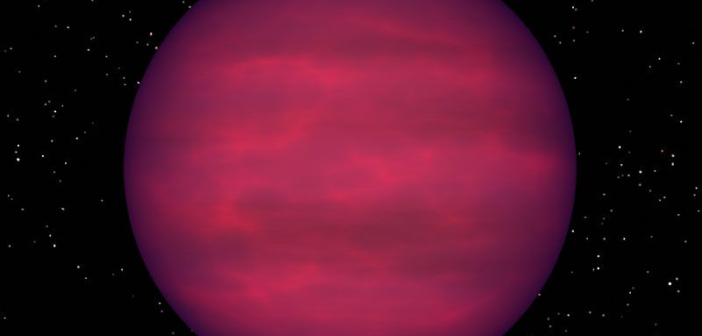Editor’s note: Astrobites is a graduate-student-run organization that digests astrophysical literature for undergraduate students. As part of the partnership between the AAS and astrobites, we repost astrobites content here at AAS Nova once a week. We hope you enjoy this post from astrobites; the original can be viewed at astrobites.org!
Title: The First Brown Dwarf Discovered by the Backyard Worlds: Planet 9 Citizen Science Project
Authors: Marc J. Kuchner, Jacqueline K. Faherty, Adam C. Schneider et al.
First Author’s Institution: NASA Goddard Space Flight Center
Status: Published in ApJL, open access
Not everyone can be a star. Brown dwarfs, for example, have failed at their attempt. These objects have masses below the necessary amount to reach pressure and temperature high enough to burn hydrogen into helium in their cores and thus earn the classification “star”. It’s not very long since we’ve learned of their existence. They were proposed in the 1960s by Dr. Shiv S. Kumar, but the first one was only observed many years later, in 1988 — and we are not even sure it is in fact a brown dwarf! We’ve only reached a substantial number of known brown dwarfs with the advent of infrared sky surveys, such as the Two Micron All Sky Survey (2MASS) and the Wide-field Infrared Survey Explorer (WISE).
Discovering and characterising cold brown dwarfs in the solar neighbourhood is one of the primary science goals for WISE. There are two ways of doing that: 1) identifying objects with the colours of cold brown dwarfs; 2) identifying objects with significant proper motion. Brown dwarfs are relatively faint objects, so they need to be nearby to be detected. We can detect the movement of such nearby targets against background stars, which are so distant that they appear to be fixed on the sky. This movement is called proper motion. As the signal-to-noise ratio is not very good for such faint objects, the second method is the preferred one. However, single exposure WISE images are not deep enough to find most brown dwarfs. This is where today’s paper enters. The authors have launched a citizen science project called “Backyard Worlds: Planet 9” to search for high proper motion objects, including brown dwarfs and possible planets orbiting beyond Pluto, in the WISE co-add images. Co-add images are simply a sum of the single exposures images taking into account corrections to possible shifts between them. This increases signal-to-noise ratio and helps to detect faint targets. In today’s paper, the authors report the first new substellar discovery of their project: a brown dwarf in the solar neighbourhood, which was identified only six days after the project was launched!
Citizen Science: A Promising Approach
The idea behind citizen science is to engage numerous volunteers to tackle research problems that would otherwise be impractical or even impossible to accomplish. The Zooniverse community hosts lots of such projects, in disciplines ranging from climate science to history. Citizen science projects have made some remarkable discoveries in astronomy, such as KIC 8462852 (aka “Tabby’s Star”, “Boyajian’s star” or “WTF star”).
In “Backyard Worlds: Planet 9”, volunteers are asked to examine short animations composed of difference images constructed from time-resolved WISE co-adds. The difference images are obtained by subtracting the median of two subsequent images from the image to be analysed. This way, if an object does not significantly move, it will disappear from the analysed image with the subtraction, leaving only moving objects to be detected. The images are also divided into tiles small enough to be analysed on a laptop or cell phone screen. The classification task consists of viewing one animation, which is composed of four images, and identifying candidates for two types of moving objects: “movers” and “dipoles”. Movers are fast moving sources, that travel more than their apparent width over the course of WISE’s 4.5 year baseline. Dipoles are slower-moving sources that travel less than their apparent width, so that there will be a negative image right next to a positive image, since the subtraction of the object’s flux will only be partial. An online tutorial is provided to show how to identify such objects and distinguish them from artifacts such as partially subtracted stars or galaxies, and cosmic rays.
The Discovery: WISEA 1101+5400

Figure 1: Two co-adds of WISE data separated by 5 years showing how WISEA 1101+5400 has moved. The region shown is 2.0” x 1.6” in size. [Kuchner et al. 2017]

Figure 2: In black, the spectrum for WISEA 1101+5400. A field T5.5 brown dwarf, SDSS J0325+0425, is shown in red for comparison. Atomic and molecular opacity sources that define the T-dwarf spectral class are indicated. [Kuchner et al. 2017]
About the author, Ingrid Pelisoli:
I am a third year PhD student at Universidade Federal do Rio Grande do Sul, in Brazil, and currently a visiting academic at the University of Warwick, UK. I study white dwarf stars and (try to) use what we learn about them to understand more about the structure and evolution of our Galaxy. When I am not sciencing, I like to binge-watch sci-fi and fantasy series, eat pizza, and drink beer.

5 Comments
Pingback: citizen search for brown dwarfs
Pingback: Taking Stock of Backyard Worlds
Pingback: Taking Stock of Backyard Worlds – Sky & Telescope – Ten15AM
Pingback: Taking Stock of Backyard Worlds – Sky & Telescope – AstroBrief
Pingback: கொல்லைப்புற உலகங்களின் பங்கு - ஸ்கை & தொலைநோக்கி - TamilNewsPapper